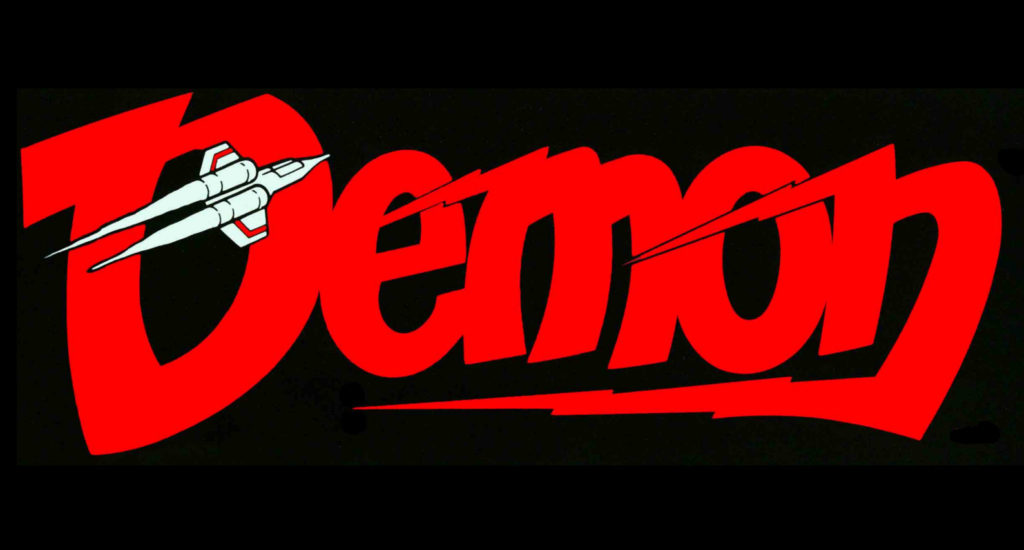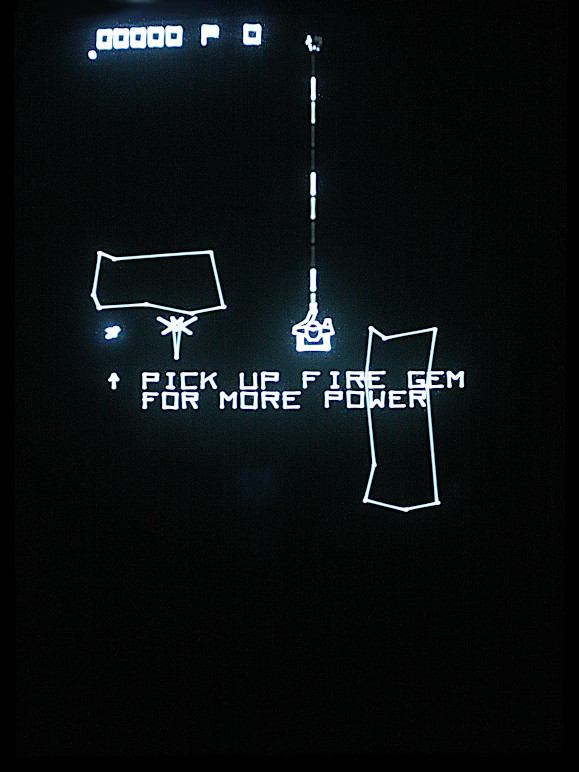VecFever documentation
Demon

Rock-Ola, 1982
Demon is my favorite game running on Cinematronics/Vectorbeam hardware – and it isn’t even by Cinematronics but was developed by Rock-Ola and never released since the American video game crash of 1982 led the Rock-Ola management to close down their video game development. At that time Demon was luckily (for us) already finished and can now be played in all its sinister glory.
The Rock-Ola soundboard for Demon -in contrast to Cinematronics- also incorporates sound chips of the time. And not any sound chips – the same 891x the Vectrex uses – which means for once the original sounds can be heard on the Vectrex as close to original as possible, too. It uses eerie sound effects, particularly the slowly changing background and the fire-like crackling of the demon is really nice.
It was probably the right decision not to release this game, though: this game would have been nice in 1979 or 1980 but by 1982 video game hardware had advanced significantly and better games were coming out. It also flickers quite a bit trying to hide/overcome these limitations, to draw a bit more, and that at the already low 38Hz refresh of the hardware. Great for playing it today on the Vectrex: a more elaborate ccpu game for once which, once you remove the ‘alternate frame’ drawing and increase the frame rate to 50Hz, looks great. And is simple enough but fun to play.
Inputs
Note: If the ‘5 button controller’ is specified as input for the vf menu this game also uses it, otherwise:
During Attract
- Button 2: start 2 player game
- Button 4: start 1 player game
In-Game
Note: the second player uses the second port controller
Buttons
- Button 1: turn left
- Button 2: turn right
- Button 3: walk
- Button 4: fire
- all four buttons together: panic
Digital Joystick
- Joystick X: turn left/right
- Button 2: panic
- Button 3: walk
- Button 4: fire
Options
- Difficulty: Normal / Hard / Insane
- Input: Buttons / Digital Joystick
- Lives: 3 / 4 / 5 / 6
- Refresh: 38Hz / 50Hz
- Reset Highscores
- Game Info: ” Welcome to Demon, the unreleased monochrome vector arcade game by Rock-Ola. This game was pretty near to being finished if not already done when Rock-Ola decided to leave the Arcade business. An interesting game concept which was ambitious in 1982 for the by then seriously aged Cinematronics CCPU hardware. So in order to display more this game has a load balancing scheme for the graphics and a wide variety of things are drawn in alternate frames only, if the time runs out. Heads and bodies of drones, explosion dots, texts, even the boulders and the letters themselves of the upper score strings are dropped. Score ‘sprites’ are even always drawn in two steps, the ’00’ in one frame and the actual values in another. And the upper score strings are drawn every other letter per frame, if at all. This results in serious flickering and a quite strange way do draw at times, too. Not something the Vectrex likes at all.. Still, for a CCPU game running on the Vectrex this was ideal: All I had to do is patch the load balancing and manage the sequence of drawing of objects to both stabilize the output and draw absolutely everything each frame. Audio was similarly well suited: Demon uses an audio board with three 8910 audio chips and a very similar 8912 is in the Vectrex. So I could grab the original audio data for once, only had to reverse engineer the audio board communication and output a pleasing soundscape with three instead of nine channels. The global-per-chip noise and alternate amplitude control was a minor concern here since Demon uses both but again prioritization and a bit of hand-holding of the sound effects did help and I am extremely pleased with the resulting soundscape. I absolutely love the menacing background sounds of the demons. “
Localization
//NAME="DEMON"
//
GERMAN[] = {
{ 0, 0, 0}
};
FRENCH[] = {
{ 0, 0, " Bienvenue dans Demon, le jeu d'arcade vectoriel monochrome inédit de Rock-Ola. Ce jeu était sur le point d'être terminé, si ce n'était déjà fait, lorsque Rock-Ola décida de quitter le monde des jeux d'arcade. Il s'agit d'un concept intéressant qui était ambitieux en 1982 pour le matériel intégrant le processeur vieillissant propre à Cinematronics (CCPU). Afin d'afficher plus d'objets, ce jeu dispose d'un système de répartition de charges pour les graphismes; une grande variété d'éléments sont dessinés, dans des images alternées uniquement, quand le temps s'écoule. Les têtes et les corps des drones, les points des explosions, les textes, ainsi que les rochers ou encore les lettres elles-mêmes des chaînes des meilleurs scores sont abandonnés. Les \"sprites\" sont quant à eux toujours dessinés en deux étapes, le \"00\" dans une image et les valeurs réelles dans un autre. Les chaînes des meilleurs scores sont dessinées dans la séquence d'une lettre sur deux pour chaque image, quand elles le sont. Il en résulte d'importants clignotements et aussi, selon le cas, une façon assez particulière de dessiner. Le Vectrex n'aime pas du tout ça... Pourtant, pour un jeu CCPU fonctionnant sur le Vectrex, c'est l'idéal : Je n'ai eu qu'à corriger l'équilibre des charges et gérer la séquence de dessin des objets pour stabiliser à la fois la sortie du signal video et dessiner absolument tout pour chaque image. L'audio s'est révélé tout aussi bien adapté : Demon utilise une carte audio avec trois puces de type 8910 ; une puce son 8912 très similaire se trouve dans le Vectrex. J'ai donc pu à ce titre récupérer les données audio originales, mais j'ai quand même dû faire de la rétro-ingénierie pour la communication de la carte audio et produire un environnement sonore adapté avec seulement trois canaux au lieu de neuf. Le bruit global par puce et le contrôle de l'amplitude alternative ont été une préoccupation mineure ici puisque Demon utilise les deux; mais encore une fois, des choix éclairés et une certaine maîtrise des effets sonores ont été utiles et je suis extrêmement satisfait de l'environnement sonore obtenu. J'adore, en fond sonore, les bruits menaçants des démons. "}
};
ENGLISH[] = {
{ 0, 0, " Welcome to Demon, the unreleased monochrome vector arcade game by Rock-Ola. This game was pretty near to being finished if not already done when Rock-Ola decided to leave the Arcade business. An interesting game concept which was ambitious in 1982 for the by then seriously aged Cinematronics CCPU hardware. So in order to display more this game has a load balancing scheme for the graphics and a wide variety of things are drawn in alternate frames only, if the time runs out. Heads and bodies of drones, explosion dots, texts, even the boulders and the letters themselves of the upper score strings are dropped. Score 'sprites' are even always drawn in two steps, the '00' in one frame and the actual values in another. And the upper score strings are drawn every other letter per frame, if at all. This results in serious flickering and a quite strange way do draw at times, too. Not something the Vectrex likes at all.. Still, for a CCPU game running on the Vectrex this was ideal: All I had to do is patch the load balancing and manage the sequence of drawing of objects to both stabilize the output and draw absolutely everything each frame. Audio was similarly well suited: Demon uses an audio board with three 8910 audio chips and a very similar 8912 is in the Vectrex. So I could grab the original audio data for once, only had to reverse engineer the audio board communication and output a pleasing soundscape with three instead of nine channels. The global-per-chip noise and alternate amplitude control was a minor concern here since Demon uses both but again prioritization and a bit of hand-holding of the sound effects did help and I am extremely pleased with the resulting soundscape. I absolutely love the menacing background sounds of the demons. "}
};

